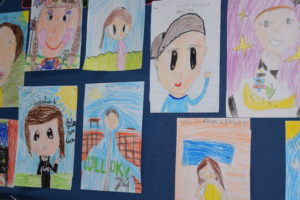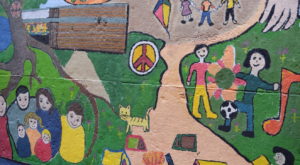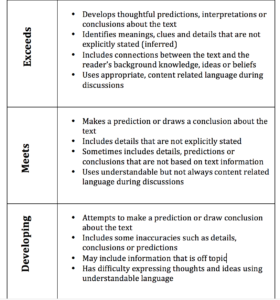Skill: Making Inferences – Using Clues in a Text to Discover What is Not Directly Stated (Recommended for grades 3 – 12)
Objectives: Students will demonstrate understanding of text by making inferences when reading. Students will become familiar with the components of an inference and make inferences based on background knowledge and clues from the text
Art Forms:
Portraiture

Muralism

Vocabulary:
Inference – a judgement based on reasoning rather than on a direct statement in a text
Identify – choose, select
Hypothesize – proposed explanation made on the basis of limited evidence as a starting point for further investigation
Justify – to show or prove to be right or reasonable
Language for Making Inferences:
Why do you think______?
How did you know______?
What probably caused_____?
What clues led you to believe______?
How might ______ feel ______?
Introduction Activity
Choose 4-5 portraits that are connected to the story you are working on. Choose actual portraits from a book (as seen below) or select portraits related to the theme or emotions of the story.
Step 1 – As a whole group “read” the portrait by talking about the following:
Facial Expression~ Eye Contact ~ Gestures ~ Clothing ~ Setting ~ Objects
Step 2 – Identify one thing that seems wrong or out of place in the picture and think about what might have caused this (i.e. Broken Wall).
Step 3 – Can you infer what is happening? Audio clip
Thinking Routines (Identify, Hypothesize, Justify)
Identify
- Identify one event from the book or story, or paragraph and think about what might have caused that event to happen (something not specifically stated or obvious)
- Or Identify how a character is feeling after a certain event or set of events
- Have students think about something they did not understand in the book and utilize the sentence frames in “Language for Making Inferences” (above)
Hypothesize
Brainstorm reasons why the identified events or emotions might have have taken place.
Create 2 or 3 hypothesis about why something might have happened. This is a starting point so the reasons should/could be simple and not very descriptive.
I think that ______________ because ______________.
Justify
Utilize background knowledge and other information from the text to elaborate on the inference made and support the inference with more specific information or evidence.
I infer that __________________ because I know ____________.
I infer that __________________ because I know that previously _____________
happened which leads me to believe _______________.
MURAL
- Each student should design or sketch a representation of their inferences (use each part of the thinking routine for inspiration)
- Create a final draft of their sketch, using markers, crayons, paint, magazine ads etc.
- Together as a class try out different ways of placing each individual art piece on a large format paper, deciding on the placement of the pieces
4. Hang or Display the mural on the wall and have students take turns coming up to the mural and explain their part, their inference: In this part of the mural, I show that ________________. I drew or designed __________ because ____________________.
Backward Looking
a.Have you done a similar kind of work in the past (earlier grades etc)?
b.Have you made something like this before?
a.What problems did you encounter while you were working on this piece? How did you solve them?
b. What was difficult for you when making _______________?
Inward Looking
a. What was especially satisfying to you about either the process of the finished product?
b. What did you like the most, working on your piece or when it was finished?
a. What did you learn about yourself as you worked on this piece?
b. When working on this project did you like reading, writing, discussing or creating?
Outward Looking
a. What is the one thing you want people to notice when they look at your piece?b. What do think others like the best about your project?
a. In what ways did your piece meet the objectives?
b. Did your piece meet the objective: ____________________________?
Forward Looking
a. What is one thing that you have seen in your classmates’ work or process that you would have liked to try?
b. What do you like about your classmates projects?
a. & b. One thing you would like to improve?

